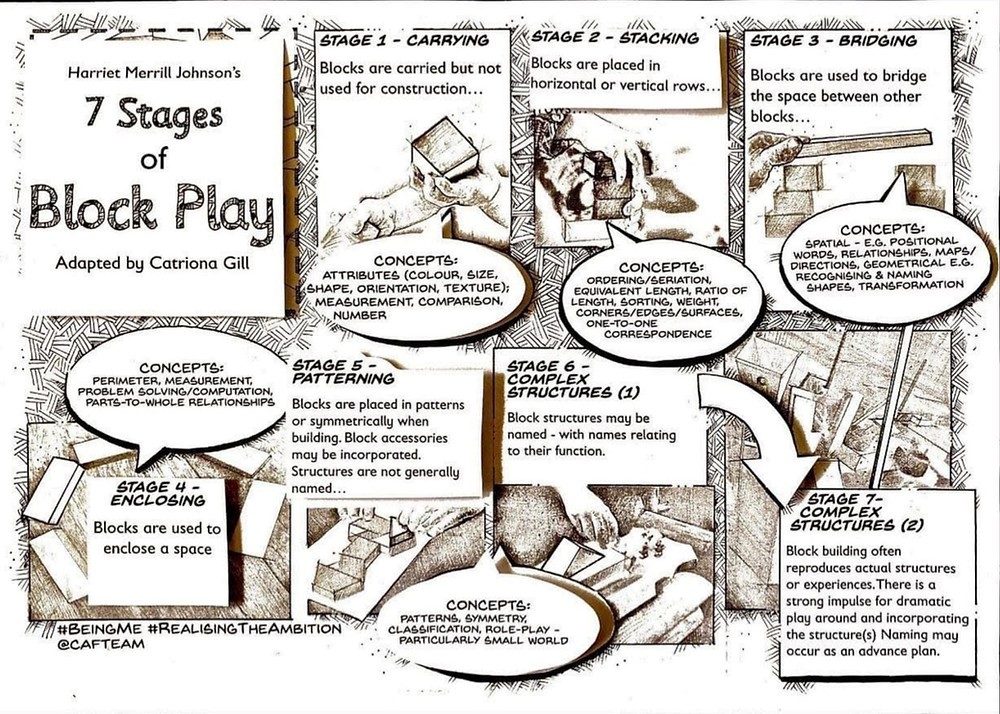Block Play
What is it?
Block play refers to free-standing, wooden blocks
Blocks are a wonderfully open-ended resource, providing children with opportunities to be creative, solve problems and develop a wide range of cross-curricular concepts. One of the reasons for children’s ongoing fascination with block play is that it is a form of play that is immensely versatile, open-ended and offers many inherent benefits.

The origins of block play lie in the simple wooden blocks introduced by Friedrich Froebel (1782 – 1852) who recognised a child’s impulse for self-activity and taking things apart and re-forming them.
There are 7 Stages of Block Play, and practitioners should have knowledge of these stages so they can accurately identify them in the children’s play and effectively extend learning.
As it states in Realising the Ambition, Education Scotland, 2020:
“Materials should be open ended to develop children’s creativity. A simple reorganisation of the resources available might be all that is needed to raise the children’s curiosity.” (p 50)
“Open-ended experiences and materials allow more exploration. They often lead to deeper and more creative learning as the child is empowered by the fact they cannot respond in a “wrong” way.” (p 65)
“Provide both open-ended and structured materials which can support and challenge my learning in literacy, numeracy and mathematical thinking, and other curricular areas, in a meaningful way.” (p 69)
“Rich block play does not just occur. It develops when the adult acts as a powerful catalyst working hard to enable it.”
(Bruce, in Gura 1992: 26)
“Block play offers an open-ended, creative and valuable play and learning experience available to every setting. It offers children freedom – to explore, take apart and put back together any block-based creation they can think of.”
(Building Learning, Block Play, PACEY, Charlie Chewter)
Key messages:
- Spaces indoors and outdoors include access to well-organised block play.
- Children use block play effectively to express themselves within their creative and imaginative play.
- Children are engrossed in deep and meaningful open-ended play using blocks.
- Blocks are accessible and can be used across different spaces in the setting, indoors and outdoors and alongside other resources, e.g. loose parts or small world.
- Practitioners observe carefully, knowing when to support and when to step back (wait, watch, wonder).
- Practitioners value the potential learning opportunities afforded using blocks, supporting opportunities for cooperation, collaboration, problem-solving, perseverance, and teamwork amongst small children (learning dispositions).
- Practitioners model the potential use of blocks and use sensitive interactions to facilitate learning opportunities and support cooperative activities (sustained shared thinking).
- Practitioners use block play to develop children’s conflict resolution and risk management knowledge.
- The use of block play significantly enhances the development of social skills, resilience and supports inclusion for all children.
Ways we can do this:
Spaces: Accessible, open-shelving with shadow labelling to facilitate the clear organisation of blocks into different shapes and sizes.
Create a large designated ‘block play’ area within your indoor and outdoor spaces.
Establish clear expectations when using this space, i.e. Do constructions need to be tidied at transition times? If not, how can children manage this independently, e.g. using photo blocks to show whose build this is/taking photos of completed projects to share and remember.
Blocks are accessible and can be used across different spaces in the setting: indoors and outdoors and alongside other resources, e.g. block play, small world, sand.
Available blocks must vary in size and shape, allowing children to develop early mathematics (shape, measure, symmetry) and STEM skills (testing hypotheses, exploring weight and balance).
Access to natural open-ended loose parts, e.g. corks, pebbles, cotton reels, to enhance the block play.
Real-life photos or images of local buildings and bridges are used to provoke interest and imaginative play.
Opportunities to promote emerging literacy and numeracy in this space are facilitated using resources, e.g. clipboards and tape measures.
Access to small world resources alongside or within block areas, e.g. animals, dinosaurs, inspires imaginative constructions and develops storytelling opportunities.
Experiences: Practitioners understand and value the potential learning of block play, e.g. the developmental stages of block play and potential learning opportunities.
Children are engrossed in deep and meaningful open-ended play using blocks, which can be evaluated using the Leuven Scale.
Practitioners spend time in this space modelling, supporting and valuing play.
Establish expectations when using block play and practitioners support children in evaluating risk, e.g. is that a safe choice?
Practitioners make creations and use blocks creatively with the children to model the potential learning opportunities.
Practitioners use observation to develop the children’s schematic use of block play, e.g. providing various materials (tubes, tunnels, boxes) to support enclosure schema or containers to facilitate the transportation of loose parts.
Practitioners use observations to identify children’s development using the 7 stages of block play, emerging literacy, developmental overviews and numeracy trackers.
Interactions: Practitioners value children’s investigation and exploration of block play and extend this through sensitive and well-timed interactions.
Practitioners make their thinking explicit to the children by verbalising what they are doing, e.g. ‘I’m building a castle – these parts are the doors, turret’ etc.
Practitioners scaffold and support children’s thinking with phrases such as “I wonder…?” using narration to explain and integrate the ideas of others.
Evidence of individual and group learning is displayed and shared with children within the setting, e.g. on wall displays, in learning journals (making learning visible). This supports the children in knowing themselves as learners.

